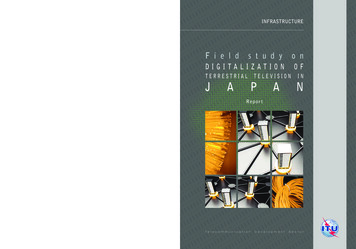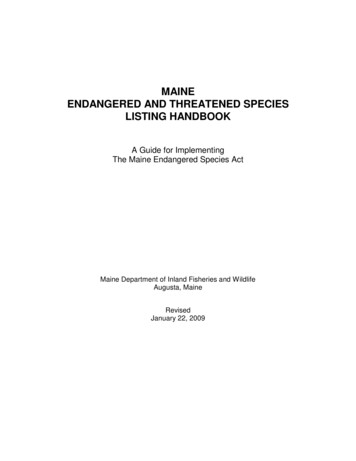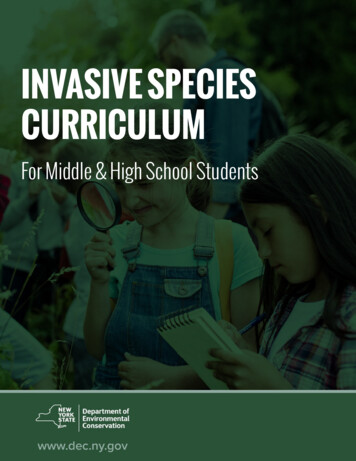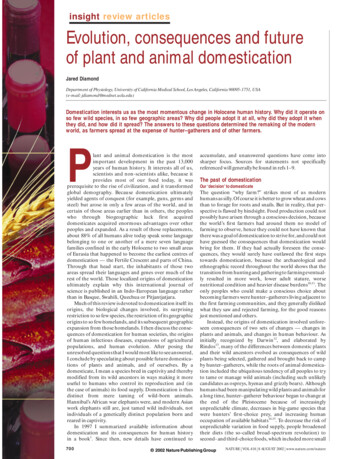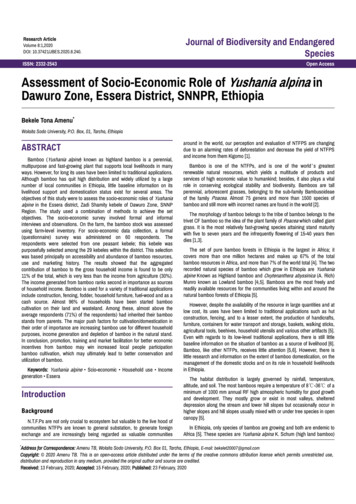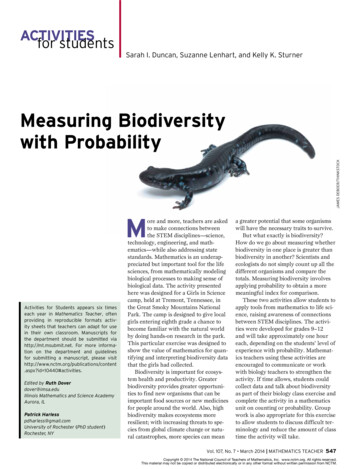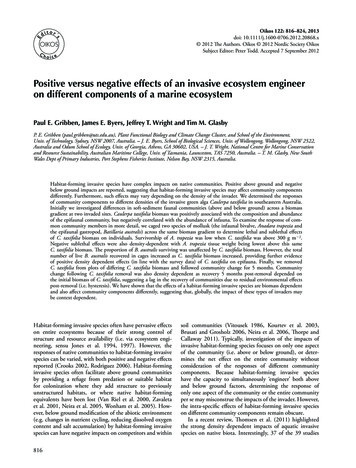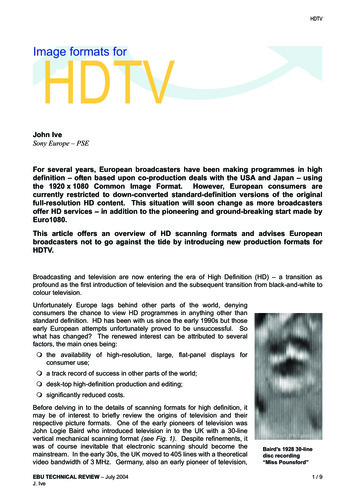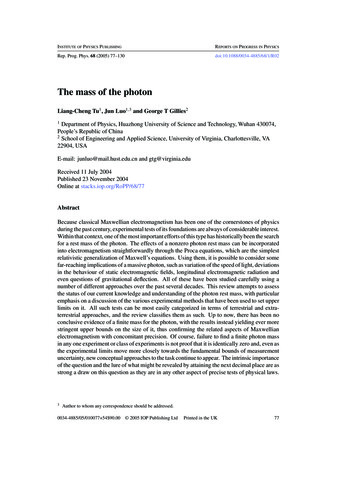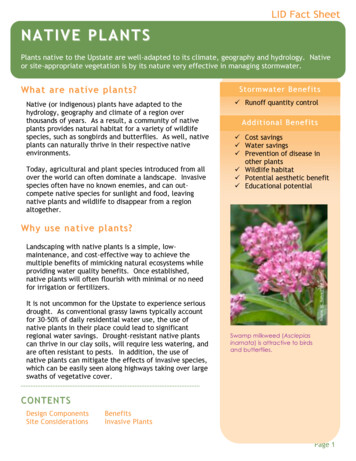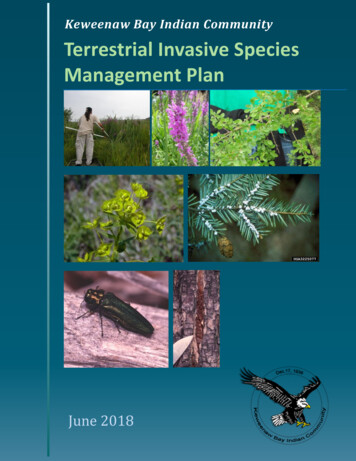
Transcription
Keweenaw Bay Indian CommunityTerrestrial Invasive SpeciesManagement PlanJune 20181
Cover photos credits:Purple Loosestrife (KBIC NRD), Japanese Barberry (KBIC NRD), Leafy Spurge (USDANISIC), Hemlock Woolly Adelgid (Michigan Invasive Species MDARD MI.gov),Emerald Ash Borer (Andrew Storer, MTU Center for Exotic Species)Citation: Keweenaw Bay Indian Community Natural Resources Department. 2018.Terrestrial Invasive Species Management Plan.http://nrd.kbic-nsn.gov/invasive-speciesKBIC NRD TISMP Working Group: Karena Schmidt, Evelyn Ravindran, Erin Johnston,Kathleen Smith, Shannon Desrochers, Rachel McDonald, Mary Hindelang2
Terrestrial Invasive Species Management PlanTable of Contents1.0 Introduction, Vision, Mission1.1 Purpose of the Terrestrial Invasive Species Management Plan1.2 KBIC Overview: Cultural Considerations, Ecosystem Impacts1.3 Companion Document to Support the Development of the TISMP1.4 Collaborative Efforts2.0 Terrestrial Invasive Species (TIS)2.1 Definitions2.2 TIS Target List and Watch List2.3 Forest Pests and Pathogens2.4 Pathways and Vectors2.5 Climate Change and TIS3.0 Management Goals, Objectives, and Actions4.0 Promoting Native Species for Revegetation5.0 Resource References and Links6.0 Species Profiles Factsheets (Appendix A)3
1.0 IntroductionKeweenaw Indian Bay CommunityTerrestrial Invasive Species Management PlanWhile holding great respect for all species, the goal of this Terrestrial Invasive SpeciesManagement Plan is to promote and protect the health and existence of native plants andanimals of ecological, cultural, or subsistence significance upon which the Keweenaw BayIndian Community depends by preventing, monitoring, and managing invasive species andeducating the community about these plants and animals.Vision Statement: To enhance and sustain the resources of the Keweenaw Bay IndianCommunity by promoting the stewardship needed to prevent and control invasive species.Mission Statement: To support, honor, and respect mutual relationships between thriving humanand plant communities by maintaining, enhancing, and restoring ecologically diverse networksof healthy habitat and respectful interactions between people and land.1.1 Purpose of the Terrestrial Invasive Species Management PlanAs invasive non-native species become established on our tribal lands they can alter the base ofarea ecosystems, diminish habitat quality, reduce forage availability, stress key native speciespopulations, degrade water quality, and compromise availability of culturally significant speciesupon which tribal members depend. The purpose of this Terrestrial Invasive SpeciesManagement Plan (TISMP) is to outline an approach for the Keweenaw Bay IndianCommunity's Natural Resources Department (KBIC NRD) to better monitor and address issuesof Terrestrial Invasive Species (TIS) within the reservation and ceded territory. This documentwill provide guidance to all Department programs regarding TIS prevention, assessment,monitoring, and control.As our world becomes more connected, the potential for species to move from one location toanother is increasing. Through intentional or non-intentional means, humans have beenresponsible for translocation of many species globally, enabling non-native species to colonizeterrestrial and aquatic environments far away from their origins. While there are many terms anddefinitions related to invasive species, all of them focus on the concept that species that are nonnative to an ecosystem may cause significant ecological and economic harm. The impact ofinvasive species is wide ranging and is one of the greatest threats to our native biodiversity.From a biodiversity perspective, invading non-native species may threaten the genetic integrityof native species, disrupt life history traits, alter geographic distribution, and reduce diversity ofhabitats on the landscape.4
1.2 KBIC Overview: Cultural Considerations, Ecosystem ImpactsKBIC is a signatory to the Treaty of 1842 and the Treaty of 1854. The Treaty of 1854 establishedReservation land bases which include the L'Anse and Ontonagon Indian Reservations. Theprimary land base is the L'Anse Indian Reservation, located in the western Upper Peninsula ofMichigan along the shores of the Keweenaw Bay of Lake Superior.Ceded territories covering the western Upper Peninsula of Michigan and northern portions ofWisconsin and Minnesota were defined by the Treaties of 1842 and 1854. KBIC retains hunting,fishing, gathering, and other usufructuary rights within these ceded territories, and tribalmembers and government staff exercise these rights for subsistence, spiritual, cultural,management, and recreational purposes.The L'Anse Indian Reservation consists of approximately 75,000 acres, 54,000 of which areland, and 21,000 of which is Lake Superior. There are approximately 19 miles of Lake Superiorshoreline, 3,000 acres of wetlands, and 80 miles of rivers within five watersheds that are eitherwholly or partially within the L'Anse Reservation boundaries. The Village of Baraga andcommunity of Zeba both lie entirely within the Reservation boundaries, while the Village ofL'Anse lies partially within the Reservation.5
The Ontonagon Indian Reservation, which is located in Ontonagon County along the LakeSuperior shoreline, is approximately 3,000 acres in size, has about 2 miles of Lake Superiorshoreline, and includes three watersheds partially within Reservation boundaries. KBIC alsoadministers approximately 200 acres of land holdings and housing in Marquette County. TheL'Anse Indian Reservation and the Ontonagon Reservation exterior boundaries are formallyrecognized by the Bureau of Indian Affairs (BIA).This TISMP will guide efforts to prevent the introduction, to reduce the spread, and to promoteappropriate management of terrestrial invasive species populations within the KBIC HomeTerritory. The “Actions” listed within the management section of this TISMP will focusprimarily on Reservation land, while the “Education” objectives and others hopefully willaddress the far reaching goal to benefit management of invasive species in all of the KBIC HomeTerritory and Ceded Territory. Because invasive species disperse widely across the landscapeand administrative boundaries, it is essential to work cooperatively towards management andcontrol objectives. In addition, the number of new exotics being introduced into local ecosystemscontinues to out-pace control activities and is too much for any one agency to manage alone.This plan is designed with consideration of tribal, federal, state, regional, and local authoritiesand laws to focus on minimizing the negative impacts caused by invasive species to naturalecosystems and native plants and animals (including humans). Many invasive species6
management plans are currently in place or being developed at the national, tribal, state, regional,and local levels and this plan is intended to work in conjunction with other plans and cooperatingagencies to protect native species in the diverse landcover types of the Reservation.The Keweenaw Bay Indian Community is dedicated to the protection of its plant resources andcommunities, preservation of its culture, and perpetuation of its traditions. The relationships weseek to nurture between people and habitat are those exchanging mutual benefits, with anemphasis on respect, reciprocity, and enduring sustainability recognizing that we cannot existwithout the food, medicine, teachings, and shelter that our habitat provides. We approach“management” as caretakers and stewards of our natural communities and continue toincorporate centuries of Anishinaabe knowledge and values through shared guardianship ofhabitat. Plants have been here long before humans. Plants are our relatives. The wisdom of plantsand the knowledge they share with us guide our approach to our plant resources. Foodsovereignty and food security become more possible with the gifts of the earth and from homeand community gardens, such as The Community People’s Garden in L’Anse, an initiative by theKeweenaw Bay Indian Community Natural Resource Department to promote gardening andnatural foods.7
As caretakers of their community, many Ojibwa people continue to harvest and use native plantsin their traditional manners and there is a strong movement toward recovering knowledgefragmented by intergenerational gaps in inherited teachings. Traditionally, gathering of plantsdone by the Ojibwa people has been for food, medicine, ceremonial materials, dyes, tools,construction, and basketry. Always has the approach to the land been governed by the guidingprinciples of the Seventh Generation.Wetlands provide enormous benefits and gifts for all species. In wetlands, invasive speciesmanagement requires a combination of strategies using methods from both terrestrial and aquaticinvasive species plans, such as with control of purple loosestrife, reed canary grass, phragmites,and European swamp thistle, to protect the precious wetlands on the Reservation.Our protective stance teaches us to know that we are responsible to share our landscape withfuture generations and we follow guiding principles (KBIC IRMP 2016 draft Plant Section) thatrecognize that all life has value, including:8
Stewardship and Relationship – the land we belong to has shaped our lives. It hasprovided food, tools, construction materials, recreation, and inspiration. Properstewardship of the land is a duty to the Seventh Generation and a vital part of the historyof the tribe. Efforts to restore and protect it will vitalize the community.Biodiversity and Pristine Habitat -- the L’Anse Reservation is home to hundreds of plantsand animals. A diverse ecosystem is more efficient in capturing energy from the sun andcycling nutrients in the soil. It is also less susceptible to disturbances and stresses such asdrought and disease that may be brought on by climate change. A diverse plantcommunity becomes home to a much more diverse group of animals than when only afew plants grow. By losing this diversity, we threaten the integrity of the ecosystem welive in and become more vulnerable to changes brought on by a quickly shifting climate.Future Resources and Security for Seven Generations – through honorable harvests,forest and wetland plants offer bountiful opportunities for enhancing the well-being ofour people. Native plants are an important resource to rescue the loss of geneticbiodiversity. As we receive teachings from more plants, we envision more members ofthe community preparing wholesome foods and effective medicines.A Foundation – Because vast tracts of land are in near pristine condition, KBIC lands canbe used to measure fluctuations in our environment and record effects of climate change.Educational Resource – Our tribal lands help us learn about the environment we live inand the other organisms that we share with it. Our strong relationship with the naturalworld enables us to share our landscape and traditions with future generationsAesthetic Value – the beauty of the Great Lakes basin is unsurpassed. The forests, openwetlands, pristine inland lakes, living sky, deep snows and hidden valleys command asense of place like no other.Over 384 plant species are recognized as being of great importance to the Anishinaabe (PlantsUsed by The Great Lakes Ojibwa (Meeker et al. 1993 GLIFWC). Our relationships with thoseof the plant nation are interwoven in a complex way. A more protective stewardship stance isneeded to assure careful consideration of decisions that may be beneficial to some species butnot to others in order to protect biodiversity, keep expanses of pristine land available for all toenjoy, and to honor the sacred trust in assuring the safeguarding of all species for generations tocome.Although some of the plants listed as invasive species are among those included in the PlantsUsed by The Great Lakes Ojibwa for their beneficial qualities, they may have originated asexotic or introduced species that have the ability to displace other species of significance. Somenon-native species have become so common and so well integrated that they have becomenaturalized or adopted, thus adding to the complexity of consideration. Botanist Robin WallKimmerer eloquently ponders the distinction between “naturalized” species in contrast to aninvasive species that brings harm in Braiding Sweetgrass: Indigenous Wisdom, ScientificKnowledge, and the Teachings of Plants. She writes:9
This wise and generous plant, faithfully following the people, became an honoredmember of the plant community. It’s a foreigner, and immigrant, but after five hundredyears of living as a good neighbor, people forget that kind of thing.Our immigrant plant teachers offer a lot of different models for how not to makethemselves welcome on a new continent. Garlic mustard poisons the soil so that nativespecies will die. Tamarisk uses up all the water. Foreign invaders like loosestrife, kudzu,and cheat grass have the colonizing habit of taking over others’ homes and growingwithout regard to limits. Being naturalized to place means to live as if this is the land that feeds you, as if theseare the streams from which you drink, that build your body and fill your spirit. Tobecome naturalized is to know that your ancestors lie in this ground. Here you will giveyour gifts and meet your responsibilities. To become naturalized is to live as if yourchildren’s future matters, to take care of the land as if our lives and the lives of all ourrelatives depend on it. Because they do. (Kimmerer 2013 pp.214-5)Additional recently published sources of Anishinaabe botanical knowledge include: OurKnowledge Is Not Primitive: Decolonizing Botanical Anishinaabe Teachings (Geniusz 2009) andPlants Have So much to Give Us, All We Have to Do Is Ask (Geniusz 2015) which use traditionalstorytelling to bring plants to life with narratives that place plants in cultural context as cognizantbeings who help us create food, simple medicines, and practical botanical tools.1.3 Companion Documents to Support the Development of the TISMPThe TISMP is a companion document to several existing documents that currently guide KBICNRD in natural resource stewardship. Current KBIC documents that address invasive non-nativespecies that were used to develop the TISMP include: Aquatic Invasive Species Management Plan (AISMP) – Adopted in 2014, the AISMP isdesigned to promote and protect the health and existence of native plants and animals ofecological, cultural, or subsistence significance upon which the Keweenaw Bay IndianCommunity depends by preventing, monitoring, and managing aquatic invasive speciesand educating the community about these plants and animals. Final%20AIS%20Plan%20Approved Merged.pdf Integrated Resource Management Plan (IRMP) – KBIC's Integrated ResourceManagement Plan sets forth goals of protecting and expanding culturally significantnative plants and identifying and controlling invasive species on the Reservation thatthreaten the existence of our native plants. Integrated resource management incorporatessubsistence and natural resources, social, cultural, environmental, and economic aspectsof importance to KBIC into management decisions. (KBIC 2016 draft).10
Wildlife Stewardship Plan (WSP) – Adopted in 2014, the WSP addresses invasive nonnative species of plants and animals in the context of promoting native species.Objectives focus on reducing negative impacts that local non-native species have on thenatural environment and directly or indirectly on native species. http://nrd.kbicnsn.gov/sites/default/files/WSP12 18 14FINAL1EO%28mh%29v52915.pdfKBIC NRD has already been making efforts in monitoring and managing invasive species, bothaquatic and terrestrial. These efforts have included, but are not limited to: Sea lamprey control Fish forage base and diet work Monitoring for AIS in collaboration with USFWS Providing boat wash services at area boat launches in collaboration with the USFS Active control of specific plant species including Japanese barberry, purple loosestrife,Eurasian water milfoil, swamp thistle, garlic mustard, spotted knapweed, reed canarygrass, Eurasian phragmites, various buckthorns, honeysuckles, and knotweeds.1.4 Collaborative EffortsCollaboration with other agencies and organizations has been a key part of KBIC’s efforts inpreventing, monitoring, controlling, and providing education and outreach for invasive species.Collaborators include: Keweenaw Invasive Species Management Area (KISMA) is a Cooperative WeedManagement Area whose mission is to facilitate cooperation and education amongfederal, state, tribal, and local groups and landowners in prevention and management ofinvasive species across land ownership boundaries within Baraga, Houghton, andKeweenaw Counties. KBIC NRD is a KISMA member and entered a Memorandum ofUnderstanding (MOU) with KISMA (currently being renewed) for them to provideassistance and expertise with invasive species management.http://www.michiganinvasives.org/kisma/ Michigan Department of Natural Resources (MDNR) plays a significant role inpreventing, monitoring, controlling, and providing outreach on invasive species thatthreaten the state. With a large part of the Ceded Territory located in Michigan,collaboration with the MDNR in preventing, monitoring, and early detection of invasivespecies is crucial. MDNR also includes restoration treatments as part of theirmanagement goals. As part of their educational outreach, the MDNR engages volunteers,landowners and partner groups and also provide maps, brochures, identification cards,videos, and workshops that are available for use in addressing terrestrial and aquatic11
invasive species. The newly released Michigan’s Terrestrial Invasive Species StateManagement Plan 2018 is a valuable resource for KBIC NRD working in collaborationwith other state agencies on controlling terrestrial invasive species. See the full documentat: http://www.michigan.gov/documents/dnr/Terrestrial invasivesp plan 618659 7.pdf Great Lakes Indian Fish and Wildlife Commission (GLIFWC) is an organizationexercising delegated authority from 11 federally recognized tribes in Minnesota,Wisconsin, and Michigan, including Keweenaw Bay Indian Community. Because ofGLIFWC’s connection with the tribes of these northern states, they are aware of and haveexperience with the detrimental impacts invasive species can have on native species thatare significant to the tribes’ culture. GLIFWC has created a number of educationalbooklets, brochures and posters to inform the general public about important tribal topics.From information about treaty rights, to fisheries management, to wild rice, to invasivespecies, these media are essential to educating people about the importance of preventingand monitoring for invasive species. Educational materials are available in electronicform on their website, or as a hardcopy. Available on their website is an interactivemapping program for viewing where invasive species (among other species) are located.To find more information about GLIFWC, visit their website at www.glifwc.org U.S. Forest Service (USFS) has implemented an Invasive Species Program which strivesto reduce, minimize, or eliminate the potential for introduction, establishment, spread,and impact of invasive species across all landscapes and ownerships. The USFS InvasiveSpecies Program’s website has many educational materials including: maps of currentinvasive species infestations, videos, flyers, reports and links to helpful resources.www.fs.fed.us/invasivespecies U.S. Fish & Wildlife Service (USFWS) is an agency within the Federal Government’sDepartment of the Interior. Within the US Fish and Wildlife Service, the Office of theNative American Liaison was created to focus on areas where federal and tribalconservation efforts intersect. USFWS is organized into regions to work with the publicand private sector to develop and implement invasive species projects. For moreinformation see: www.fws.gov Midwest Invasive Species Information Network (MISIN) is a regional effort to developand provide early detection and response resources for invasive species with the goal toassist both experts and citizen scientists in the detection and identification of invasivespecies in support of successful management. This effort is being led by researchers withthe Michigan State University Entomology Laboratory. https://www.misin.msu.edu/ Iron Baraga Conservation District is one of Michigan's 77 Conservation Districts whichprovides natural resource management services and information to help local citizensmanage their lands and preserve our environment. http://www.ironcd.org/12
2.0 Terrestrial Invasive Species (TIS)2.1 DefinitionsInvasive species can be plants, animals, pests, or pathogens and can be aquatic (in the water) orterrestrial (on the land) living outside their native range. Non-native species may not alwayscause harm but many invasive species are more aggressive and quickly out-compete nativespecies for space and resources, as they are free from natural predators, reproduce rapidly, andaggressively compete with native species (KBIC NRD 2014). Invasive plants can cause dramaticecological changes that impact both plant and animal communities. This is often due tolandscape transformations that reduce the adaptability and competitiveness of more desirednative species. Such transformations are linked to the excessive use of resources by invasiveplants. There is a great variety in terms and definitions when it comes to TIS; following arerelevant terms and their definitions.Native (or indigenous) species is defined as native to a given region or ecosystem if its presencein that region is the result of only natural processes, with no human intervention. Every naturalorganism has its own natural range of distribution in which it is regarded as native (US Legal2014).Non-native (or nonindigenous) species is defined as a species living outside its nativedistributional range, which has arrived by human activity, either deliberate or accidental. Nonnative species can have various effects on the local ecosystem. Introduced species that have anegative effect on a local ecosystem are also known as invasive species. Not all non-nativespecies are considered invasive. Some have no known negative effect and can, in fact, bebeneficial (MBL 2013).Invasive species is defined as a plant or animal that is not native to a specific location (anintroduced species). Invasive species have a tendency to spread, and are believed to causedamage to the environment, human economy and/or human health (NISC 2006).Noxious species is defined as a species that has been officially declared by a federal, state, tribal,or county government entity to be injurious to native ecosystems and wildlife habitats, cropland,and rangeland agriculture, and/or humans, livestock, and wildlife, and to be the target ofrecommended or mandatory management efforts (BIA 2014).Naturalized species is defined as a process by which a non-native organism spreads into the wildand its reproduction is sufficient to maintain its population (UCANR 2014).A non-native plant that does not need human help to reproduce and maintain itself over time inan area where it is not native is considered naturalized (USDA). Many naturalized plants arefound primarily near human-dominated areas and, sometimes the terms naturalized or adopted13
are used to refer specifically to naturally reproducing, non-native plants that do not invade areasdominated by native vegetation.Alien is a term used by The University of Michigan Herbarium to describe non-native speciesthat are of great concern for natural communities, thought to have been accidentally or purposelyintroduced from elsewhere in the world. Many are plants that have escaped from managedsettings in gardens or arboreta to spread and become established. The majority of species thathave been introduced persist and increase, though it may not be obvious for decades. Often afterthey have become invasive, sensitive native plants are compromised. More than one third ofMichigan’s flora now is non-native and this number will increase. Species included in theHerbarium flora are updated frequently with notes about where and when a new alien has beencollected and is an excellent reference tool for early detection. It is intended to be an evolvingillustrated website incorporating updates and new discoveries as soon as they are documentedand verified. Updated information about the diversity and occurrence of plants is essential tounderstanding and stewarding Michigan’s environment and appreciating its natural heritage. (Seehttp://michiganflora.net/home.aspx)Some invasive plants are distinctive and easily recognized but many others are difficult todistinguish from species of our native flora. It is important to use helpful tips and photographslike those in Appendix A: Species Profile Factsheets and other valuable resources such asMistaken Identity (Sarver et al. /Mistaken Identity Final.pdf2.2 TIS Target List and Watch ListAn important step to an effective TISMP is to identify which species are already established asinvasive species within the KBIC Home Territory and which TIS are on the horizon. Species onthe Target List are those that are known to be present in our area and species on the Watch Listhave been identified as being an immediate and significant threat. The KBIC TIS Target andWatch List (Appendix A) is composed of four sections: Invasive Plants Target List, InvasivePlants Watch List, Invasive Wetland Plants List, and Invasive Insects and Pathogens. Keeping inmind that the status of invasive species is always changing, these lists contain the species ofconcern at this present time. Although not currently found in the KBIC Home Territory, TIS onthe Watch List are included because of the potential of these species to cause significantecosystem, cultural, and economic impacts if found here in the future. This TISMP is a livingdocument and will be updated as new species of concern/interest are identified.For each species on the target and watch lists, the following information is provided: Descriptionand photographs, Origin and Spread, Habitat, Impact and Ecological Threat, Prevention andControl, Reporting and Education.14
2.3 Forest Pests and PathogensInvasive pests and pathogens pose a potential threat to the forests across KBIC Home Territory.KBIC Forestry Division works cooperatively with KBIC NRD, the BIA, United States ForestService, and state and private forestry agencies for identification, monitoring, and managementobjectives, including prevention and management of invasive species.While there are native insects and organisms that help maintain ecosystem function, non-nativepest and pathogens pose threats to individual species and entire forested ecosystems. BecauseKBIC forests are extensive, yet located within a fragmented ownership landscape, BestManagement Practices (BMPs) including Integrated Pest Management (IPM) are recommendedapproaches to protect forests from insects and pathogens through species diversification andreducing tree stress.Specific infestations often have only one tree species or genus as a host (for example, EmeraldAsh Borer, Oak Wilt, Hemlock Woolly Adelgid). By promoting tree species diversity, the riskof mortality by pathogens and pests is minimized. Current timber sale specifications often retainor otherwise promote minor tree species in the stand, and this practice should be continued.Pests and pathogens are much more likely to attack and kill stressed trees. In contrast, healthytrees are more likely to compartmentalize an infection and survive. Therefore in stands wheretrees are obviously stressed and exhibit signs of decline, harvesting declining trees can preventfurther mortality and loss.Being aware of up-coming potential insect and pathogen issues can help minimize losses.Michigan DNR has updated forest health information which has been helpful along with otherresources in this plan. The insects and pathogens on the target and watch list have been selectedbased on the tree species present or likely to occur in the near future on KBIC lands. Severalpathogens and pests are of local and current importance to the L’Anse Reservation. While notall of the potential and current pests can be addressed here, the priority pests are identifiedbecause of their threat to forest and cultural resources for the KBIC.2.4 Pathways and VectorsPathways are the means by which species are transported from one location to another. Naturalpathways include wind, currents, and other forms of dispersal. Man-made pathways are thosepathways which are enhanced or created by human activity. These pathways can be eitherintentional or unintentional. The term vector is viewed as a biological pathway for a disease orparasite to be transmitted from one source (plant or animal) to another. Vectors are the mode ofintroduction of pathogens.Although it is conceivable that a TIS introduction might happen through entirely natural vectorsand pathways, in most cases, humans are involved along every step of the way. Humans havedeveloped pathways that make TIS introductions possible. Gardens, plantings, and human modes15
of transportation combined with commercial and recreational practices, such as ATV and hikingand ski trails, act as mechanisms by which TIS-occupied vectors can move along a pathway fastenough to arrive at a new environment with the TIS still in a viable state. “Hitchhikers” can becarried by hikers, boats, tires, horses, pets, shipping material, highway or construction projects,firefighting equipment, even forest restoration projects can carry seeds, spores, or larvae fromone place to another, unexpectedly introducing a pest species somewhere it has not existedbefore. Human in
invasive species that brings harm in Braiding Sweetgrass: Indigenous Wisdom, Scientific Knowledge, and the Teachings of Plants. She writes: 10 This wise and generous plant, faithfully following the people, became an honored member of the plant community. It's a foreigner, and immigrant, but after five hundred
